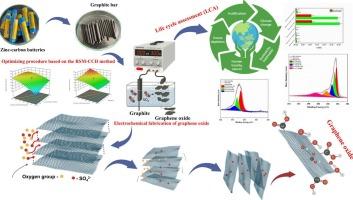废旧电池氧化石墨烯绿色电化学升级:工艺优化、结构表征和生命周期评估
IF 9.2
2区 工程技术
Q1 ENERGY & FUELS
引用次数: 0
摘要
随着材料科学对可持续实践的需求日益增强,本研究提出了一种环境友好的电化学途径,利用废旧锌碳电池回收的石墨棒合成氧化石墨烯(GO)。传统的方法,如悍马和改进的悍马技术,涉及危险化学品和浓酸,造成严重的环境和健康问题。相比之下,我们的方法利用中性硫酸钠电解质进行电化学氧化,从而实现更安全,更清洁的过程,消除有害的副产品。采用响应面法和中心复合设计对电解液浓度、外加电压和反应时间等工艺参数进行优化,以确保效率和重现性。通过x射线衍射、傅里叶变换红外光谱、拉曼光谱、x射线光电子能谱、扫描电子显微镜和紫外可见分析对所得氧化石墨烯进行了广泛的表征。结果表明,氧化石墨烯具有良好的氧化介孔结构,保留了sp2碳框架,同时可控地引入了含氧官能团。此外,一项全面的生命周期评估强调了该方法相对于传统合成路线的环境优势,显示出温室气体排放、酸化、生态毒性和臭氧消耗潜力的显著减少。这项工作符合循环经济和清洁生产的原则,为从电子废物中获得增值碳纳米材料提供了一条可持续的途径。本文章由计算机程序翻译,如有差异,请以英文原文为准。

Green electrochemical upcycling of spent batteries into graphene oxide: Process optimization, structural characterization, and life cycle assessment
As the demand for sustainable practices in materials science intensifies, this study presents an environmentally benign electrochemical route for synthesizing graphene oxide (GO) using graphite rods recovered from spent zinc–carbon batteries. Traditional methods such as the Hummers and modified Hummer's techniques involve hazardous chemicals and concentrated acids, posing significant environmental and health concerns. In contrast, our approach utilizes a neutral sodium sulfate electrolyte for electrochemical oxidation, enabling a safer, cleaner process that eliminates harmful byproducts. Process parameters, including electrolyte concentration, applied voltage, and reaction time, were optimized using Response Surface Methodology with a Central Composite Design to ensure efficiency and reproducibility. The resulting GO was extensively characterized by X-ray diffraction, Fourier-transform infrared spectroscopy, Raman spectroscopy, X-ray photoelectron spectroscopy, scanning electron microscopy, and UV–Visible analysis. The results revealed a well-oxidized, mesoporous GO structure that retained its sp2 carbon framework while introducing oxygen-containing functional groups in a controlled manner. Furthermore, a comprehensive life cycle assessment highlighted the environmental advantages of this method over conventional synthesis routes, showing significant reductions in greenhouse gas emissions, acidification, eco-toxicity, and ozone depletion potential. This work aligns with the principles of the circular economy and cleaner production, offering a sustainable pathway for value-added carbon nanomaterials from electronic waste.
求助全文
通过发布文献求助,成功后即可免费获取论文全文。
去求助
来源期刊

Sustainable Materials and Technologies
Energy-Renewable Energy, Sustainability and the Environment
CiteScore
13.40
自引率
4.20%
发文量
158
审稿时长
45 days
期刊介绍:
Sustainable Materials and Technologies (SM&T), an international, cross-disciplinary, fully open access journal published by Elsevier, focuses on original full-length research articles and reviews. It covers applied or fundamental science of nano-, micro-, meso-, and macro-scale aspects of materials and technologies for sustainable development. SM&T gives special attention to contributions that bridge the knowledge gap between materials and system designs.
 求助内容:
求助内容: 应助结果提醒方式:
应助结果提醒方式:


